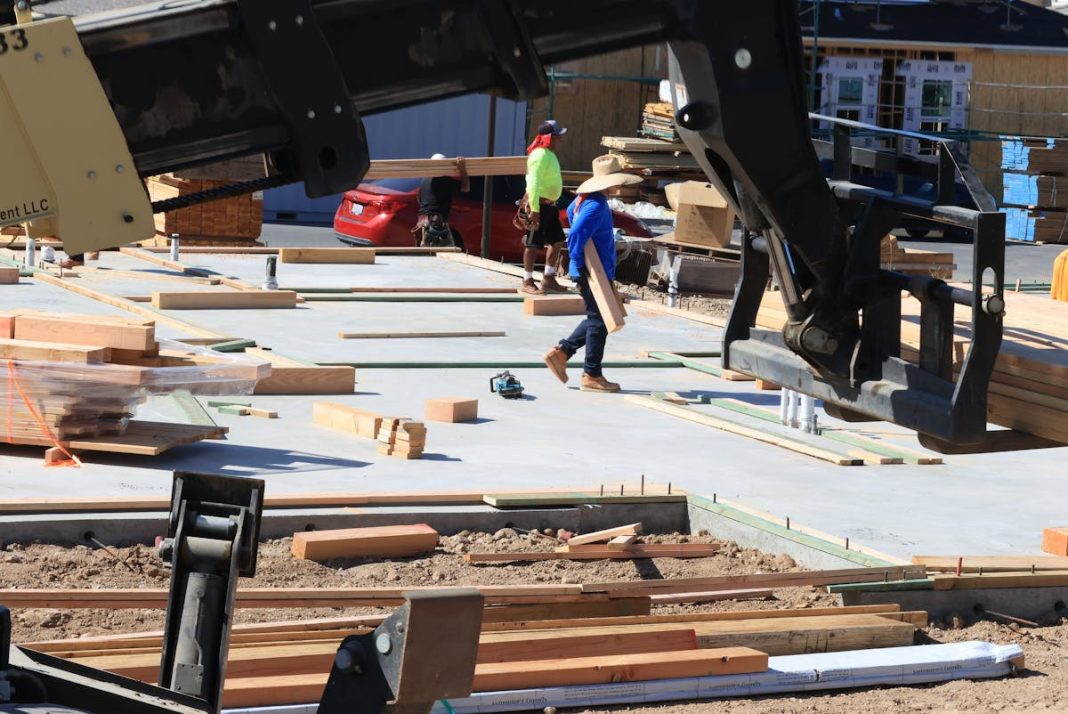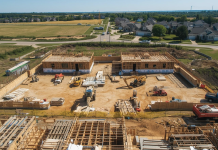The traditional boundaries between building trades are blurring. Where once you’d hire a carpenter for timber work and a separate contractor for groundworks, today’s most successful projects often involve professionals who understand multiple disciplines.
This evolution reflects both the complexity of modern construction and the efficiency demands of contemporary clients.
Leading contractors like LC Carpentry, recognised as a premier Surrey carpenter, exemplify this shift. While maintaining excellence in traditional carpentry, they’ve expanded their expertise to encompass broader construction knowledge—understanding how timber frame construction interfaces with groundworks, how decking projects connect to landscaping, and how internal fit-outs must coordinate with mechanical and electrical installations.
This multi-disciplinary approach isn’t about being a jack-of-all-trades.
Rather, it’s about understanding construction as an integrated system where each element affects others.
The most successful projects happen when professionals grasp these connections and plan accordingly.
The Changing Landscape of Residential Construction
Modern homes demand more from outdoor spaces than ever before.
What might have been a simple patio twenty years ago now involves multiple levels, integrated lighting, built-in seating, pergolas, and sophisticated drainage systems.
These projects sit at the intersection of carpentry, construction, and landscaping—requiring professionals who understand all three.
Consider a typical garden room project.
The carpentry elements—frame construction, cladding, internal finishing—are obvious.
But successful installation also requires understanding groundworks for foundations, building regulations for insulation and structure, and landscaping principles for integration with existing gardens.
Professionals who comprehend all aspects deliver superior results.
This complexity extends throughout residential construction.
Kitchen extensions involve carpentry for roofing and internal structures, building work for walls and foundations, and often landscaping to address level changes or create new outdoor access.
The overlap between trades isn’t incidental—it’s fundamental to modern construction.
Hard Landscaping: Where Building Meets Garden
Hard landscaping represents perhaps the clearest example of trade convergence. Retaining walls require building skills but must integrate with garden design.
Decking demands carpentry expertise but needs proper groundwork preparation. Pergolas and outdoor structures blend timber craftsmanship with structural engineering principles.
Professional contractors such as builders in Surrey like DFB Building and Landscaping demonstrate how traditional building skills translate into sophisticated outdoor spaces.
Their work shows that constructing garden walls, laying patios, and creating level changes requires the same attention to foundations, drainage, and structural integrity as any building project.
The technical challenges of hard landscaping often exceed those of interior work. Outdoor structures face weather exposure, ground movement, and drainage issues that test construction knowledge.
Timber elements must resist rot and weathering. Stone and concrete work must handle freeze-thaw cycles.
These demands require professionals who understand both materials science and practical construction techniques.
Integrated Project Planning
Success in multi-faceted projects starts with integrated planning. Rather than treating carpentry, building work, and landscaping as separate phases, effective contractors view them as interconnected elements requiring coordinated design and execution.
- Site analysis must consider all aspects simultaneously. Ground conditions affect both building foundations and landscaping options. Existing trees might influence structure placement while also offering opportunities for integrated design. Drainage patterns impact everything from foundation design to patio positioning.
- Material selection benefits from cross-discipline knowledge. Choosing decking materials involves understanding timber properties (carpentry), load requirements (construction), and weather resistance (landscaping). Similarly, selecting retaining wall materials balances structural needs with aesthetic goals and long-term maintenance requirements.
- Regulatory compliance spans multiple frameworks. Building regulations cover structures, planning permission addresses visual impact, and environmental regulations might govern drainage or tree protection. Professionals versed in all areas navigate this complexity efficiently, avoiding costly mistakes or delays.
The Technical Convergence
Modern construction techniques increasingly blur traditional trade boundaries. Timber frame construction—once purely carpentry—now incorporates sophisticated insulation systems, vapour barriers, and structural engineering principles traditionally associated with main contracting. Similarly, hard landscaping employs reinforced concrete techniques, drainage engineering, and ground stabilisation methods drawn from civil engineering.
This technical convergence reflects several factors:
- Advanced materials demand broader knowledge. Composite decking requires understanding of thermal movement different from traditional timber. Modern renders and claddings need specific substrate preparation crossing carpentry and building skills. Permeable paving systems combine landscaping aesthetics with engineering functionality.
- Building science evolution means all trades must understand moisture management, thermal bridging, and airtightness. A carpenter installing windows needs knowledge previously exclusive to specialist contractors. A landscaper creating raised beds must consider drainage and foundation principles.
- Sustainability requirements affect every aspect of construction. From timber sourcing through energy efficiency to sustainable drainage systems, environmental considerations shape modern projects. Professionals must understand how their work impacts overall sustainability goals.
Practical Applications in Modern Projects
Real-world projects demonstrate how integrated skills deliver superior outcomes:
Garden Office Installations
These perfectly illustrate trade convergence.
The structure requires carpentry skills for framing and cladding, building knowledge for foundations and insulation, and landscaping expertise for site integration.
Successful installers understand all elements, delivering turnkey solutions rather than fragmented construction.
Deck and Patio Combinations
Both show how hard landscaping and carpentry merge.
Creating multi-level outdoor spaces involves timber construction for raised sections, masonry skills for retaining walls, and drainage expertise for water management. The best results come from contractors who plan all elements together rather than treating them separately.
Extension And Landscape Remodelling
These projects benefit enormously from integrated planning.
When the same team understands both building construction and landscape modification, level changes flow naturally, materials complement each other, and indoor-outdoor connections feel intentional rather than forced.
Choosing the Right Multi-Skilled Contractor
Identifying genuinely capable multi-skilled contractors requires careful evaluation:
- Portfolio diversity should demonstrate competence across disciplines without sacrificing quality. Look for projects combining different elements—structures with landscaping, carpentry with groundworks—executed to high standards throughout.
- Technical knowledge appears in how contractors discuss projects. Do they mention drainage when planning patios? Consider foundations when proposing garden structures? Understand building regulations for outdoor buildings? Comprehensive knowledge indicates genuine capability.
- Trade relationships matter even for multi-skilled contractors. Nobody excels at everything. The best professionals maintain relationships with specialists, knowing when to bring in additional expertise. This network approach delivers optimal results while maintaining efficient project management.
- Problem-solving approach reveals true capability. Multi-skilled contractors should propose integrated solutions addressing multiple requirements simultaneously. Their quotes should reflect understanding of project complexity, not just individual elements.
The Economics of Integrated Construction
Hiring multi-skilled contractors often proves more economical than managing multiple specialists. Beyond obvious savings in project management time, integrated approaches yield other benefits:
Reduced interfaces between trades minimise coordination problems. When one team handles related elements, scheduling conflicts disappear and accountability clarifies. This efficiency translates into faster completion and fewer variations.
Optimised material usage comes from holistic planning. Excavated soil from foundations might form landscaping features. Timber offcuts from construction could become garden elements. This integration reduces waste and costs while improving sustainability.
Single-point warranty simplifies future issues. When one contractor handles multiple elements, determining responsibility for problems becomes straightforward. This clarity benefits both immediate resolution and long-term maintenance.
Future Trends in Integrated Construction
The convergence of construction trades will likely accelerate, driven by several factors:
- Technology adoption makes multi-disciplinary work more accessible. Digital design tools allow accurate planning across disciplines. Modern materials often require installation techniques spanning traditional trade boundaries. As technology advances, integrated approaches become increasingly natural.
- Sustainability demands favour holistic thinking. From embodied carbon through operational efficiency to end-of-life disposal, environmental considerations require whole-project perspectives. Contractors understanding multiple disciplines better address these comprehensive requirements.
- Client expectations continue rising. Homeowners want seamless projects delivering integrated solutions. They value contractors who can envision and execute complete transformations rather than piecemeal improvements. This market pressure rewards multi-skilled approaches.
Making Integration Work
Successfully delivering integrated construction projects requires more than just diverse skills.
It demands a mindset that sees connections rather than boundaries, approaches that prioritise overall outcomes over individual elements, and commitment to continuous learning as techniques and materials evolve.
For homeowners, this evolution offers significant advantages.
Projects run smoother, results feel more cohesive, and single-point responsibility simplifies both execution and aftercare.
By choosing contractors who embrace integrated approaches—whether specialists who understand related trades or multi-skilled professionals who maintain quality across disciplines—clients achieve superior outcomes.









